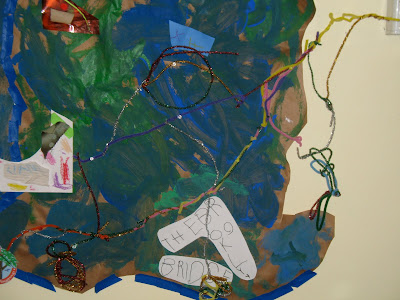
Last summer I led a themed, 2-week long "session" of my school's summer program that was loosely centered around the Hudson River and the New York Harbor. Pete Seeger's Sloop Clearwater was sailing down river to dock in Brooklyn for a couple of days in the summer, so I took advantage of the opportunity and put together a session entitled "Rolling on the River". My school is in a neighborhood that is directly on the Brooklyn waterfront, so we had easy access to waterfront piers and parks.
To pull the unit together I decided to turn our classroom into the New York Harbor, by creating a large harbor mural that would cover an entire wall of the classroom. During the first week of the session, we visited the nearby parks and piers, and talked about what we could see in the harbor. We read stories about rivers and animals that live in rivers and, as a group, we wrote our own story about a whale that gets lost in the New York Harbor (based on true events!) During the second week, we went for a ride on the Staten Island Ferry and visited the Sloop Clearwater.
The kids did a fantastic job painting our mural, deciding what needed to go in our harbor, crafting the parts, and writing the labels (with the teachers help for spelling). We had cranes:

boats:

the Verrazano Bridge:

the Brooklyn Bridge:

and, of course, the Statue of Liberty:

We also used streamers, thick ribbons, and fabric to create the East River and the Hudson River, which extended from the harbor wall to other walls in the classroom. The children posted these handy labels as a guide, which delighted the mapper in me:


In addition to getting to do all of this artwork, the session ended up being a great way to get outside during the summer, to explore our school's neighborhood, and go on some fun field trips!























